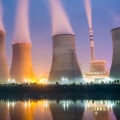The potential for nuclear submarines to pollute the ocean is a pressing concern for many nations. In this article, we will explore the consequences of nuclear weapons, radioactive waste dumps, and sunken submarines on the Arctic marine environment. The compartments of nuclear submarines are made of thick steel walls that are not easily damaged. The reactor is cooled with an unlimited amount of water, while the nuclear cores are made of uranium and plutonium, which are not soluble in water.
Despite this, there is still a risk of corrosion and leakage. The United States Navy has dumped low-activity nuclear waste into coastal waters, and Chairman of the House Military Research and Development Subcommittee Kurt Weldon (R) of Pennsylvania has called for an international effort to assess military radioactive contamination of seas. Meanwhile, Russia's civil agency Rosatom is in charge of the cleanup, but there is little incentive for the Russian military to stop this nuclear wave. Two sunken submarines containing large amounts of cesium-137 are currently at the bottom of the Atlantic Ocean with their nuclear reactors in place.
Ingar Amundsen, head of international nuclear safety at the Norwegian Nuclear Safety and Radiation Authority, believes it is only a matter of time before these submarines pollute waters if left as is. The USS Carl Vinson, an aircraft carrier powered by two nuclear reactors, is docked near San Diego, California. The disaster involving this submarine has been one of the few nuclear submarine accidents that have attracted public attention. It is equipped with two Mark 45 torpedoes with nuclear tips.
The dismantled parts of nuclear submarines contain substantial radioactivity and dumping them at sea would be in contravention of the current global moratorium on this practice. The CTB report has called on the European Commission to seek immediate international negotiations “to stop the global danger emanating from lost nuclear weapons”.The Department of Energy (DOE) discards some types of contaminated reactor parts from nuclear ships at Hanford facility in Washington State. The next nuclear cleanup is expected to be the largest of its kind in history, but it may prove to be just a prelude to what is needed to deal with the next wave of nuclear power in the Arctic.






